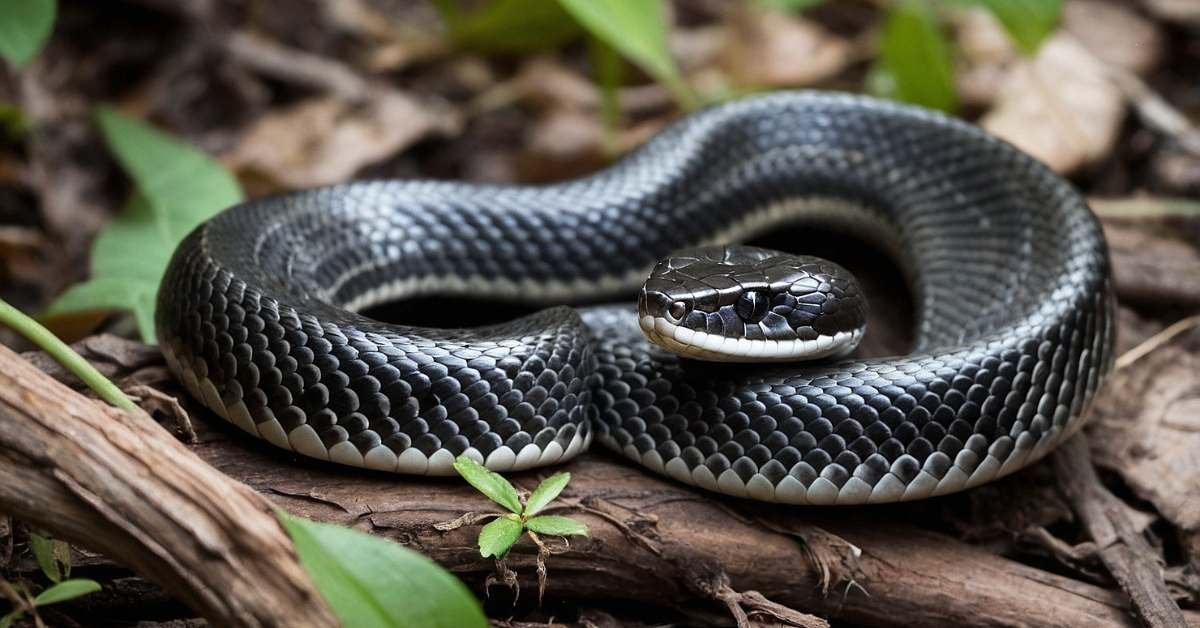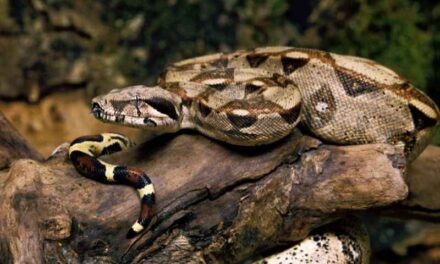The black rat snake (Pantherophis obsoletus) is a non-venomous colubrid snake found in central and eastern North America. This species is an apex predator of small mammals, birds, and other reptiles, playing a crucial role in its ecosystem. This article offers a comprehensive overview of the black rat snake’s diet and hunting habits, synthesizing information from various scientific investigations.
Diet of the Black Rat Snake
Black rat snakes are opportunistic feeders with a diverse diet. While rodents, including mice, rats, chipmunks, and voles, are their primary food source, they also consume a variety of other prey 1. The following table provides a more detailed overview of their diet:
| Prey Category | Examples | Citation(s) |
| Mammals | Mice, rats, chipmunks, voles, squirrels, rabbits | 1 |
| Birds | Birds, bird eggs | 4 |
| Amphibians and Reptiles | Frogs, lizards, snakes | 1 |
| Insects | Moths | 4 |
The size and age of a black rat snake influence its dietary preferences. Juvenile black rat snakes primarily feed on smaller prey, such as insects and frogs, while adults shift their focus to warm-blooded animals like rodents and birds 1. Studies have shown that larger snakes tend to consume larger prey and reduce their consumption of smaller prey items 4.
Adaptations for Hunting and Prey Consumption
Black rat snakes have evolved several adaptations that make them effective hunters:
- Excellent Climbers: Their strong, muscular bodies and keeled scales enable them to climb trees and other vertical surfaces with ease 2. This climbing ability allows them to access a wider range of prey, including birds, eggs, and tree-dwelling rodents.
- Constriction: As constrictors, black rat snakes subdue their prey by coiling their bodies around it and squeezing until it suffocates 8. This technique allows them to overpower animals larger than their heads 2. It’s important to note that constriction does not involve crushing bones or preventing breathing; instead, it overwhelms the circulatory system, leading to rapid death 1.
- Detachable Jaw: Black rat snakes, like other snakes, possess a flexible jaw structure that allows them to swallow prey much larger than their heads 3.
- Camouflage: Their dark coloration provides effective camouflage in their natural environment, aiding in ambushing prey and avoiding predators 3.
- Venom Control: While non-venomous, black rat snakes can control the amount of venom they inject when biting defensively 11. This adaptation helps conserve venom for legitimate threats and prevent unnecessary harm to non-prey animals.
- Olfactory Acuity: Smell is the primary sensory organ for black rat snakes, playing a crucial role in locating prey and navigating their environment 10. Their keen sense of smell allows them to detect prey trails and identify potential food sources.
Habitat and Its Influence
Black rat snakes are highly adaptable and inhabit a diverse range of habitats, including forests, grasslands, and suburban areas 2. They also utilize rock outcroppings and stone walls for shelter 12. Their habitat influences their diet and hunting habits in several ways:
Forests: In forested environments, black rat snakes have access to a greater abundance of arboreal prey, such as birds and tree-dwelling rodents. The complex structure of forests provides ample opportunities for ambush predation, with snakes often concealing themselves in tree cavities or among branches.
Grasslands: In grasslands, black rat snakes primarily prey on ground-dwelling rodents and lizards. The open terrain may necessitate more active foraging strategies, with snakes relying on their speed and agility to capture prey.
Thermoregulation: As ectotherms, black rat snakes rely on external heat sources to regulate their body temperature. Habitat features, such as access to sunlight and suitable basking sites, influence their activity patterns and foraging behavior 5. Gravid females, in particular, show a preference for habitats with low overstory canopy cover, likely to maximize exposure to sunlight for thermoregulation 13.
Winter Denning: During the colder months, black rat snakes exhibit a unique behavior by denning with other snake species, including venomous ones 14. This communal denning behavior may provide benefits such as increased warmth and protection from predators.
Hunting Habits and Techniques
Black rat snakes employ a variety of hunting techniques, demonstrating their adaptability and resourcefulness:
- Ambush: They often lie in wait for prey in concealed locations, such as tree cavities, under logs, or within rock crevices 1.
- Active Foraging: They actively search for prey, utilizing their keen sense of smell and sight to locate potential meals 3. Their home range typically covers about 25 hectares, but they may occasionally venture over a kilometer in search of food 10.
- Climbing: Their exceptional climbing ability allows them to access bird nests and other arboreal prey 9.
Research on the link between snake activity and nest predation has yielded varied results, highlighting the complexity of predator-prey relationships and the need for further investigation 15.
Defense Mechanisms
When threatened, black rat snakes utilize a range of defense mechanisms to deter predators:
- Freezing: They may freeze in place, relying on their camouflage to avoid detection 3.
- Tail Rapping: They may vibrate their tails against leaves or other surfaces, mimicking the sound of a rattlesnake to startle potential predators 3.
- Striking: If further provoked, they may strike at the threat 3.
- Musk Release: When captured, they release a foul-smelling musk from anal scent glands to discourage predators 3.
Role in the Ecosystem
Black rat snakes are integral components of their ecosystems, fulfilling important roles as both predator and prey:
- Predator: They help regulate populations of rodents, birds, and other small animals, contributing to the balance of the food web 14. Their presence can have cascading effects on the ecosystem, potentially benefiting plant communities by reducing seed predation and herbivory 16.
- Prey: They serve as a food source for larger predators, such as hawks, owls, and foxes 2.
Interestingly, a common misconception is that black rat snakes “pilot” venomous snakes to dens 6. This belief likely stems from their habit of sharing winter dens with other snake species. However, there is no evidence to support this claim, and it’s important to dispel such myths to promote accurate understanding of snake behavior.
Ongoing Research
Ongoing research continues to expand our knowledge of black rat snake ecology:
- Habitat Use and Movement Patterns: Scientists are using radio telemetry and other tracking methods to study how black rat snakes utilize different habitats and how their movements are influenced by factors such as prey availability, seasonality, and thermoregulation 15.
- Impact of Habitat Fragmentation: Studies are investigating how habitat fragmentation and urbanization affect black rat snake populations and their interactions with other species 5.
- Dietary Shifts and Adaptations: Researchers are examining how black rat snake diets vary across different geographic regions and how they adapt to changes in prey availability 4.
Black rat snakes are highly adaptable predators with a diverse diet that includes rodents, birds, and other small animals. Their climbing ability, constriction technique, and keen sense of smell are crucial adaptations for hunting success. As apex predators, they play a vital role in regulating prey populations and maintaining the balance of their ecosystems.
This article has provided a detailed overview of the black rat snake’s diet and hunting habits, drawing upon a variety of research findings. By understanding the feeding ecology of this species, we can gain a deeper appreciation for its importance in the natural world and contribute to its conservation.
Works cited
1. Rat snake facts | Live Science, accessed on March 13, 2025, https://www.livescience.com/53855-rat-snake.html
2. Black Rat Snake – Chesapeake Bay Program, accessed on March 13, 2025, https://www.chesapeakebay.net/discover/field-guide/entry/black-rat-snake
3. All About Black Rat Snakes – Grit, accessed on March 13, 2025, https://www.grit.com/animals/wildlife/black-ratsnake-zm0z15jazreg/
4. Seasonal and Prey-size Dietary Patterns of Black Ratsnakes (Elaphe obsoleta obsoleta), accessed on March 13, 2025, https://bioone.org/journals/the-american-midland-naturalist/volume-150/issue-2/0003-0031_2003_150_0275_SAPDPO_2.0.CO_2/Seasonal-and-Prey-size-Dietary-Patterns-of-Black-Ratsnakes-Elaphe/10.1674/0003-0031(2003)150[0275:SAPDPO]2.0.CO;2.short
5. HABITAT USE BY BLACK RAT SNAKES (ELAPHE OBSOLETA OBSOLETA) IN FRAGMENTED FORESTS, accessed on March 13, 2025, https://mysite.science.uottawa.ca/gblouin/articles/006_2001_brs_habitat.pdf
6. 10 Amazing Black Rat Snake Facts – Chattahoochee Nature Center, accessed on March 13, 2025, https://www.chattnaturecenter.org/visit/experience/wildlife/animal-facts/black-rat-snake/
7. Black Rat Snake, accessed on March 13, 2025, https://dep.nj.gov/wp-content/uploads/njfw/black_rat_snake.pdf
8. All About Rat Snakes – Nextgen Pest Solutions, accessed on March 13, 2025, https://ngpest.com/wildlife-removal/snake-removal/all-about-rat-snakes/
9. Eastern Rat Snake | National Wildlife Federation, accessed on March 13, 2025, https://www.nwf.org/Educational-Resources/Wildlife-Guide/Reptiles/Black-Rat-Snake
10. Black Rat Snake – Hiker’s Notebook, accessed on March 13, 2025, https://hikersnotebook.blog/fauna/reptiles-and-amphibians/black-rat-snake/
11. Rat snake | Diet, Habitat & Lifespan | Britannica, accessed on March 13, 2025, https://www.britannica.com/animal/rat-snake
12. Black Rat Snake | The Maryland Zoo, accessed on March 13, 2025, https://www.marylandzoo.org/animal/black-rat-snake/
13. BLACK RAT SNAKE – Dirt to Trees to Wildlife, accessed on March 13, 2025, https://www.dirttreeswildlife.org/black-rat-snake
14. Black Rat Snake Facts and Information | United Parks & Resorts – SeaWorld.org, accessed on March 13, 2025, https://seaworld.org/animals/facts/reptiles/black-rat-snake/
15. Do seasonal patterns of rat snake (Pantherophis obsoletus) and black racer (Coluber constrictor) activity predict avian nest predation? – PubMed Central, accessed on March 13, 2025, https://pmc.ncbi.nlm.nih.gov/articles/PMC4831437/
16. Black Rat Snakes: A Closer Look at North America’s Largest Snakes, accessed on March 13, 2025, https://showmereptileshow.com/resources/black-rat-snakes-a-closer-look-at-north-americas-largest-snakes
17. Habitat Use by Black Rat Snakes (Elaphe obsoleta obsoleta) in Fragmented Forests, accessed on March 13, 2025, https://www.researchgate.net/publication/242075490_Habitat_Use_by_Black_Rat_Snakes_Elaphe_obsoleta_obsoleta_in_Fragmented_Forests





